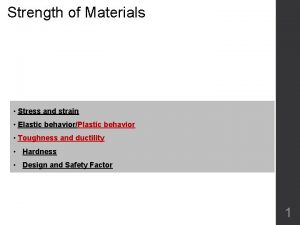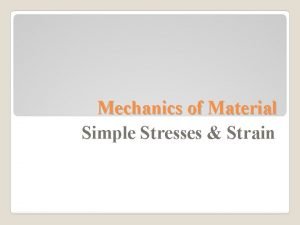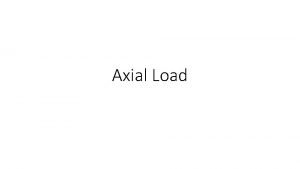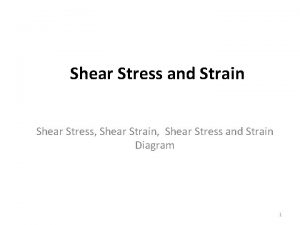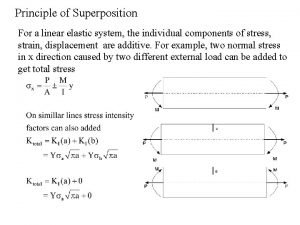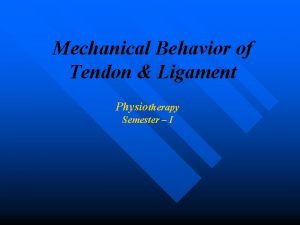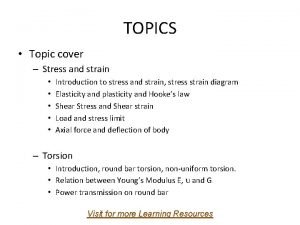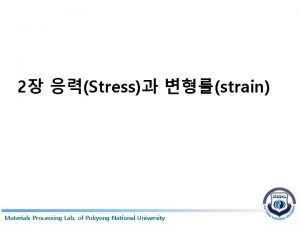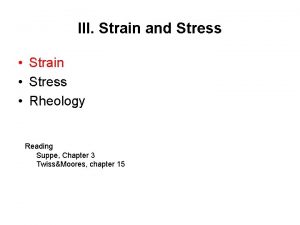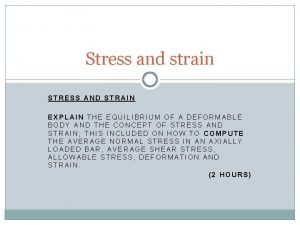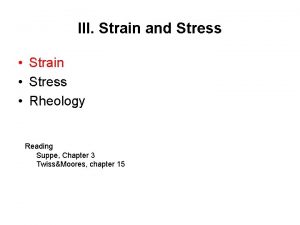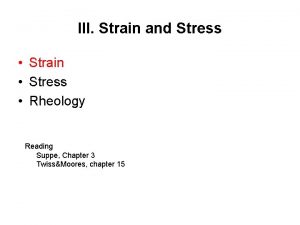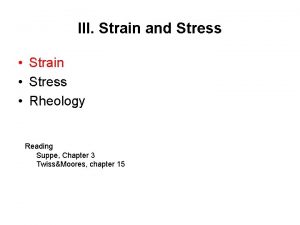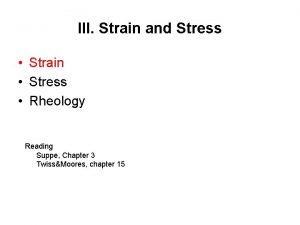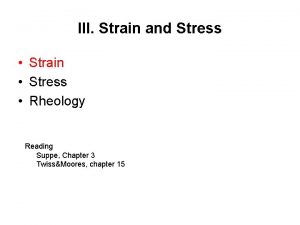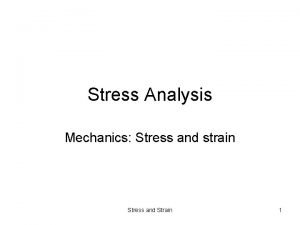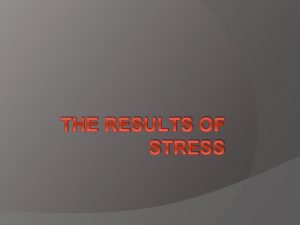STEM Stress Strain Key Terms Stress Strain Forces


















































- Slides: 50

STEM Stress Strain

Key Terms Stress Strain Forces Shear Torsion Load Beam Modulus of rigidity Objective: SWBAT show stress and strain apply to mechanical failure or everyday objects like scissors

Lesson Objective SWBAT show stress and strain apply to mechanical failure or everyday objects like scissors By summarizing the information given in this weeks lecture Objective: SWBAT show stress and strain apply to mechanical failure or everyday objects like scissors

You will be successful if… Make a checklist of the following items and check yourself off during the lesson. You can explain how scissors cut. You can mathematically describe how a piece of metal fails You can explain Space X’s latest rocket failure of a strut Is there anything you can add, or would take away in order to help you meet our lesson objective this week Objective: SWBAT show stress and strain apply to mechanical failure or everyday objects like scissors

Introduction- Monday Stress and strain Introduction to stress and strain, stress strain diagram Elasticity and plasticity and Hooke’s law Shear Stress and Shear strain Load and stress limit Axial force and deflection of body Torsion Introduction, round bar torsion, non-uniform torsion. Relation between Young’s Modulus E, and G Power transmission on round bar Objective: SWBAT show stress and strain apply to mechanical failure or everyday objects like scissors

Diving in Shear Force and bending moment Introduction, types of beam and load Shear force and bending moment Relation between load, shear force and bending moment Bending Stress Introduction, Simple bending theory Area of 2 nd moment, parallel axis theorem Deflection of composite beam Objective: SWBAT show stress and strain apply to mechanical failure or everyday objects like scissors

Non Simetric Bending Introduction, non-simetric bending Product of 2 nd moment area, determination of stress Shear Stress in beam Introduction, Stream of shear force Shear stress and shear strain in edge beam Deflection of Beam Introduction Equation of elastic curve, slope equation and integral deflection Statically indeterminate Beams and shaft Objective: SWBAT show stress and strain apply to mechanical failure or everyday objects like scissors

Fun video or picture describing subject Objective: SWBAT show stress and strain apply to mechanical failure or everyday objects like scissors

DIRECT STRESS When a force is applied to an elastic body, the body deforms. The way in which the body deforms depends upon the type of force applied to it. Compression force makes the body shorter. A tensile force makes the body longer Objective: SWBAT show stress and strain apply to mechanical failure or everyday objects like scissors

Connections to past Your whole life you’ve been using scissors to cut, and have hole punched papers. How can this relate to stress or strain? Objective: SWBAT show stress and strain apply to mechanical failure or everyday objects like scissors

Connections to future Have you ever seen a car wreck where a car was split in half? How can measuring stress or strain help you stay safe in the future? Objective: SWBAT show stress and strain apply to mechanical failure or everyday objects like scissors

Heavy Tensile and compressive forces are called DIRECT FORCES Stress is the force per unit area upon which it acts. …. . Unit is Pascal (Pa) or ( Symbol – Sigma) Note: Most of engineering fields used k. Pa, MPa, GPa. Objective: SWBAT show stress and strain apply to mechanical failure or everyday objects like scissors

DIRECT STRAIN , In each case, a force F produces a deformation x. In engineering, we usually change this force into stress and the deformation into strain and we define these as follows: Strain is the deformation per unit of the original length. The symbol called EPSILON Objective: SWBAT show stress and strain apply to mechanical failure or everyday objects like scissors

Direct Strain cont. Strain has no unit’s since it is a ratio of length to length. Most engineering materials do not stretch very mush before they become damages, so strain values are very small figures. It is quite normal to change small numbers in to the exponent for 10 -6( micro strain). Objective: SWBAT show stress and strain apply to mechanical failure or everyday objects like scissors

Objective Review-Monday What was our objective? Discussion- Put todays objective in your own words and talk to your partner about it. I’ll call on 3 people at random. What did you and your partner come up with? Does anyone have something different. Objective: SWBAT show stress and strain apply to mechanical failure or everyday objects like scissors

Criteria for success- Mon Are you meeting our criteria for success? How? (notes here on peardeck) Objective: SWBAT show stress and strain apply to mechanical failure or everyday objects like scissors

MODULUS OF ELASTICITY (E) • • Elastic materials always spring back into shape when released. They also obey HOOKE’s LAW. This is the law of spring which states that deformation is directly proportional to the force. F/x = stiffness = k. N/m Objective: SWBAT show stress and strain apply to mechanical failure or everyday objects like scissors

• The stiffness is different for the different material and different sizes of the material. We may eliminate the size by using stress and strain instead of force and deformation: • If F and x is refer to the direct stress and strain , then hence and Objective: SWBAT show stress and strain apply to mechanical failure or everyday objects like scissors

The stiffness is now in terms of stress and strain only and this constant is called the MODULUS of ELASTICITY (E) A graph of stress against strain will be straight line with gradient of E. The units of E are the same as the unit of stress. ULTIMATE TENSILE STRESS • If a material is stretched until it breaks, the tensile stress has reached the absolute limit and this stress level is called the Objective: SWBAT show stress and strain ultimate tensile stress. apply to mechanical failure or everyday objects like scissors

STRESS STRAIN DIAGRAM

Rate yourself How well do you feel you’ve met the objective according to the Ouchi rubric grading scale. 1 2 3 4 Objective: SWBAT show stress and strain apply to mechanical failure or everyday objects like scissors

Objective review-Mo Why is our objective relevant outside of Ouchi HS? Objective: SWBAT show stress and strain apply to mechanical failure or everyday objects like scissors

Criteria for success Objective: SWBAT show stress and strain apply to mechanical failure or everyday objects like scissors

Objective Review- Wed Objective: SWBAT show stress and strain apply to mechanical failure or everyday objects like scissors

Criteria for success- Review Objective: SWBAT show stress and strain apply to mechanical failure or everyday objects like scissors

Popcorn Objective: SWBAT show stress and strain apply to mechanical failure or everyday objects like scissors

Fun vid or sample vid Objective: SWBAT show stress and strain apply to mechanical failure or everyday objects like scissors

STRESS STRAIN DIAGRAM Elastic behaviour The curve is straight line trough out most of the region Stress is proportional with strain Material to be linearly elastic Proportional limit The upper limit to linear line The material still respond elastically The curve tend to bend and flatten out Elastic limit Upon reaching this point, if load is remove, the specimen still return to original shape

STRESS STRAIN DIAGRAM Yielding A Slight increase in stress above the elastic limit will result in breakdown of the material and cause it to deform permanently. This behaviour is called yielding The stress that cause = YIELD STRESS@YIELD POINT Plastic deformation Once yield point is reached, the specimen will elongate (Strain) without any increase in load Material in this state = perfectly plastic

STRESS STRAIN DIAGRAM STRAIN HARDENING When yielding has ended, further load applied, resulting in a curve that rises continuously Become flat when reached ULTIMATE STRESS The rise in the curve = STRAIN HARDENING While specimen is elongating, its cross sectional will decrease The decrease is fairly uniform NECKING At the ultimate stress, the cross sectional area begins its localised region of specimen it is caused by slip planes formed within material Actual strain produced by shear strain As a result, “neck” tend to form Smaller area can only carry lesser load, hence curve donward Specimen break at FRACTURE STRESS

SHEAR STRESS • Shear force is a force applied sideways on the material (transversely loaded). When a pair of shears cut a material When a material is punched When a beam has a transverse load

ØShear stress is the force per unit area carrying the load. This means the cross sectional area of the material being cut, the beam and pin. • Shear stress, and symbol is called Tau ØThe sign convention for shear force and stress is based on how it shears the materials as shown below.

Objective Review Thursday Objective: SWBAT show stress and strain apply to mechanical failure or everyday objects like scissors

Criteria for success Thurs Objective: SWBAT show stress and strain apply to mechanical failure or everyday objects like scissors

SHEAR STRAIN The force causes the material to deform as shown. The shear strain is defined as the ratio of the distance deformed to the height . Since this is a very small angle , we can say that : Shear strain ( symbol called Gamma)

MODULUS OF RIGIDITY (G) • If we conduct an experiment and measure x for various values of F, we would find that if the material is elastic, it behave like spring and so long as we do not damage the material by using too big force, the graph of F and x is straight line as shown. The gradient of the graph is constant so and this is the spring stiffness of the block in N/m. • If we divide F by area A and x by the height L, the relationship is still a constant and we get

• If we divide F by area A and x by the height L, the relationship is still a constant and we get Where then This constant will have a special value for each elastic material and is called the Modulus of Rigidity (G).

ULTIMATE SHEAR STRESS If a material is sheared beyond a certain limit and it becomes permanently distorted and does not spring all the way back to its original shape, the elastic limit has been exceeded. If the material stressed to the limit so that it parts into two, the ultimate limit has been reached. The ultimate shear stress has symbol and this value is used to calculate the force needed by shears and punches.

Connections to past Learning Objective: SWBAT show stress and strain apply to mechanical failure or everyday objects like scissors

Connections to future learning Objective: SWBAT show stress and strain apply to mechanical failure or everyday objects like scissors







Criteria for success? Rate yourself 1 -4 1 -What are we doing? 2 - I got 1 of them 3 - I got all of them 4 - I understand them and can apply them to other subjects Objective: SWBAT show stress and strain apply to mechanical failure or everyday objects like scissors

Supplementary example Objective: SWBAT show stress and strain apply to mechanical failure or everyday objects like scissors

Example cont. Objective: SWBAT show stress and strain apply to mechanical failure or everyday objects like scissors

Copy link to peardeck! Pear deck www. peardeck/join Objective: SWBAT show stress and strain apply to mechanical failure or everyday objects like scissors
 Elastic strain and plastic strain
Elastic strain and plastic strain Elasticdeformation
Elasticdeformation True strain equation
True strain equation Strain diagram
Strain diagram Mechanics of material
Mechanics of material Elastic modulus dental materials
Elastic modulus dental materials Stress strain coping support model
Stress strain coping support model St venant principle
St venant principle Orthotropic material examples
Orthotropic material examples Strain energy stored in a hollow shaft
Strain energy stored in a hollow shaft Stresses
Stresses Principle of superposition in stress and strain
Principle of superposition in stress and strain Gerinim birimi
Gerinim birimi Strain energy formula a level physics
Strain energy formula a level physics Stress strain curve physiotherapy
Stress strain curve physiotherapy Selbstregulation
Selbstregulation Stress and strain reading outline
Stress and strain reading outline St venant principle
St venant principle 탄성계수
탄성계수 Polynomial classification
Polynomial classification Identify like terms
Identify like terms Like parallel forces example
Like parallel forces example The forces shown above are pushing/pulling forces
The forces shown above are pushing/pulling forces Intramolecular forces vs intermolecular forces
Intramolecular forces vs intermolecular forces Difference between intramolecular and intermolecular
Difference between intramolecular and intermolecular Covalent bond intermolecular forces
Covalent bond intermolecular forces What is contact force
What is contact force Unbalanced force
Unbalanced force Destructive process examples
Destructive process examples Business model canvas
Business model canvas Key partners key activities key resources
Key partners key activities key resources Definition of axial stress
Definition of axial stress Chapter 10 stress responses and stress management
Chapter 10 stress responses and stress management Chapter 5 section 4 the minor parties reviewing key terms
Chapter 5 section 4 the minor parties reviewing key terms Key terms in postcolonial theory
Key terms in postcolonial theory Key marketing terms
Key marketing terms Chapter 11 nutrition and diet
Chapter 11 nutrition and diet Review exercise terms and events answer key
Review exercise terms and events answer key Reviewing key terms
Reviewing key terms Burudika na coke baridi
Burudika na coke baridi Geometry key words
Geometry key words Chapter 11 nutrition and diets
Chapter 11 nutrition and diets Define the following key terms
Define the following key terms Nature of strategic management
Nature of strategic management Behaviourist approach key terms
Behaviourist approach key terms Health care responsibilities
Health care responsibilities Key terms examples
Key terms examples Long division method
Long division method Key terms chemical bonds
Key terms chemical bonds Buddhism key terms
Buddhism key terms Emigrated vs immigrated
Emigrated vs immigrated
